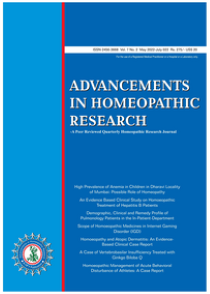Candida Albicans Infections: Can Homoeopathy Offer a Solution? - A Narrative Review
DOI:
https://doi.org/10.48165/ahr.2025.10.3.5Keywords:
Antifungal, Candida albicans, Clotrimazole, Homoeopathy, In-vitro, In-vivoAbstract
Background: Typically, the human body has the yeast Candida albicans, which is mostly located in the gut, vagina, throat, and mouth. It is the most prevalent fungal infection in humans. Seventy-five percent of women have had vaginal candidiasis at least once a lifetime and 5-8% of them relapse while they are at their most fertile. Immunocompromised individuals, denture wearers, and young children are all susceptible to oral candidiasis. Because of the emergence of drug resistance, new antifungal medications are required for the effective treatment of Candida albicans infection. Objective: The current study's objectives are to reduce issues, encourage an early recovery, provide specific homoeopathic treatment with symptomatic improvement, support utilize homoeopathy in the management and prevention of fungal maladies, and assess the efficacy of homoeopathic medications in suppressing Candida albicans. An overview of the pathogenicity traits, clinical manifestations, and participation of Candida albicans in invasive infections is provided by the review. Method: A variety of automated database literature searches were performed in order to gather and condense pertinent articles. These searches included Research Gate, PubMed and Google Scholar. Result: Homoeopathy on Candida albicans have been shown to have possibilities for novel and dependable techniques for inhibiting fungal infections. Interpretation: This review discusses the methods and the remedies to inhibit Candida albicans & the significance of homoeopathic medicine's antifungal properties
References
Edwards, J. E. (2015). Candidiasis. In Harrison’s Principles of Internal Medicine (20th ed., Part 5, Section 16, p. 1529). New York: McGraw-Hill.
Zhou, X., Li, T., Fan, S., Zhu, Y., Liu, X., Guo, X., & Liang, Y. (2016). The efficacy and safety of clotrimazole vaginal tablet vs. oral fluconazole in treating severe vulvovaginal candidiasis. Mycoses, 59(7), 419–428.
Noble, S. M., Gianetti, B. A., & Witchley, J. N. (2017). Candida albicans cell-type switching and functional plasticity in the mammalian host. Nature Reviews Microbiology, 15(2), 96–108.
Martins, N., Ferreira, I. C., Henriques, M., & Silva, S. (2016). In vitro anti-Candida activity of Glycyrrhiza glabra L. Industrial Crops and Products, 83, 81–85.
Draskau, M. K., Rosenmai, A. K., Scholze, M., Pedersen, M., Boberg, J., Christiansen, S., & Svingen, T. (2021). Human-relevant concentrations of the antifungal drug clotrimazole disrupt maternal and fetal steroid hormone profiles in rats. Toxicology and Applied Pharmacology, 422, 115554.
Kaur, L., Kaur, R., Singh, A., & Kaur, N. (2021). A brief review on ethnobotanical, pharmaceutical and therapeutical uses of Glycyrrhiza glabra. Seeds, 49, 50.
Davidson’s Principles and Practice of Medicine (24th ed., pp. 343–344, 1093). (2019). Edinburgh: Elsevier.
Talapko, J., Juzbašić, M., Matijević, T., Pustijanac, E., Bekić, S., Kotris, I., & Škrlec, I. (2021). Candida albicans – the virulence factors and clinical manifestations of infection. Journal of Fungi, 7(2), 79.
Chen, H., Zhou, X., Ren, B., & Cheng, L. (2020). The regulation of hyphae growth in Candida albicans. Virulence, 11(1), 337–348.
Basmaciyan, L., Bon, F., Paradis, T., Lapaquette, P., & Dalle, F. (2019). Candida albicans interactions with the host: Crossing the intestinal epithelial barrier. Tissue Barriers, 7(2), 1612661.
Deorukhkar, S. C., & Roushani, S. (2017). Virulence traits contributing to pathogenicity of Candida species. Journal of Microbiology & Experimentation, 5(1), 00140.
Martins, N., Ferreira, I. C., Barros, L., Silva, S., & Henriques, M. (2014). Candidiasis: Predisposing factors, prevention, diagnosis and alternative treatment. Mycopathologia, 177, 223–240.
Tripathi, K. D. (2018). Essentials of Medical Pharmacology (8th ed., pp. 838–847). New Delhi: Jaypee Brothers Medical Publishers.
Haddaway, N. R., Page, M. J., Pritchard, C. C., & McGuinness, L. A. (2022). PRISMA 2020.
Mercado, C. X., & Kluthe, B. G. (2021). Fungicidal effects of homoeopathic medicines versus allopathic ketoconazole in Candida albicans. Indian Journal of Research in Homoeopathy, 15(4), 3.
Munshi, R., Talele, G., & Shah, R. (2022). In-vitro evaluation of antimicrobial activities of Escherichia coli, Klebsiella pneumoniae, Salmonella typhi, Neisseria gonorrhoeae, and Candida albicans nosodes. Homeopathy, 111(1), 42–48.
Shinde, C. H., Anand, P. K., Kunchiraman, B. N., & Jadhav, A. B. (2018). In vitro study for the anti-Candida activity of homoeopathic medicines against Candida albicans. International Journal of Health Sciences and Research, 8(9), 57–61.
Murugesh, J., Annigeri, R. G., Mangala, G. K., Mythily, P. H., & Chandrakala, J. (2019). Evaluation of the antifungal efficacy of different concentrations of Curcuma longa on Candida albicans: An in vitro study. Journal of Oral and Maxillofacial Pathology, 23(2), 305.
Prajapati, S., Sharma, M., Gupta, P., Kumar, M., Dwivedi, B., & Arya, B. (2017). Evaluation of antifungal activity of different homoeopathic mother tinctures against Candida albicans. Indian Journal of Research in Homoeopathy, 11(4), 237–243.
Zida, A., Bamba, S., Yacouba, A., Ouedraogo-Traore, R., & Guiguemdé, R. T. (2017). Anti-Candida albicans natural products, sources of new antifungal drugs: A review. Journal de Mycologie Médicale, 27(1), 1–9.
Gupta, G., Srivastava, A., Gupta, N., Gupta, G., & Mishra, S. (2015). Anti-candidal activity of homoeopathic drugs: An in-vitro evaluation. Indian Journal of Research in Homoeopathy, 9(2), 79–85.




